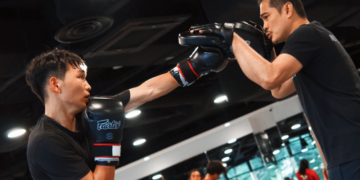
Brazilian Jiu-Jitsu is a highly dynamic martial art that relies on positioning, movement, and technique. Many positions in BJJ are deemed must-learn to stay competitive on the mats. A good example of this is the dogfight position from half-guard. It is a position that’s very useful in all grappling situations, including mixed martial arts. Today we’ll discuss this position in detail.
Position Before Submission
Positional dominance is perhaps one of the most critical skills to learn in grappling. Being able to physically dominate someone using proper leverage ensures that you stay on the offensive and simultaneously force the opponent to exert more energy in a given exchange.
Focusing on positional dominance alone can help you win matches, as pins and reversals are awarded points in most grappling rulesets. Many of yesterday’s and today’s top BJJ athletes are masters in using their bodies to positionally overwhelm their competition. Some examples of these great athletes include Ricardo Arona, Andre Galvao, Kaynan Duarte and the late Orlando Sanchez.
Becoming a submission expert is always a valuable asset to have, but it is not guaranteed that you’ll snatch a submission in your matches. For this reason, we encourage you to allot more time to positional work than submission drilling.
The Dogfight Half-Guard
The dogfight is a position in the half-guard where you are side to side with your opponent while in the kneeling position. The key benefit of using the dogfight is that it keeps you relatively safe from submissions and, at the same time, opens up opportunities to sweep, take the back and recover guard.
Check out this this video as 10th Planet black belt Brandon Mccaghren shares the basics of the dogfight half-guard.
The best time to go for the dogfight is when your opponent decides to smash you using their body weight. From the basic knee shield position, allow the opponent to initiate their offense by lowering your defenses slightly. This will encourage them to go forward and go for a pressure pass. Keep everything tight by holding your arms near your torso as they attempt to smash.
When you see them move forward, now is the time to work on getting your underhook as you block their cross face and switch your legs. The final step is to go to your knees while keeping the underhook. Doing these movements correctly should land you in the dogfight position.
A typical reaction of your opponent is to secure the whizzer and push you over. Counter these threats by moving in a circular motion to deflect their force and to open up opportunities to sweep and take the back.
Offensive Dogfight
Here is a follow-up video that teaches two techniques you can apply from the dogfight – the Old School Sweep and Plan B. We mentioned previously that your opponent would most likely counter your underhook with a whizzer. Once they do go for the whizzer, reposition your body while keeping your underhook and move towards their hip as you grab their foot.
Once you grab their foot, you can sweep them forward by pushing them toward the side of the grabbed foot; this technique is called the Old School Sweep. This sweep is an extremely high percentage move and will catch many unsuspecting training partners. If the opponent defends by either basing out or sprawling their unhooked leg, you can use the Plan B sweep to reverse them to the other side.
These two sweeps will form the base of your dogfight sweeps, as they are considered the essential techniques in the position. There are many other techniques available from the dogfight, but for now, it is best to master these sweeps, and you’ll be on your way to becoming a better, more dangerous grappler.
Play around with these techniques, and feel free to switch from one move to another depending on how your opponent reacts to your movements. The dogfight is a technical position with many moving parts. Be mindful of your position in relation to your opponent, and always be on the lookout for incoming attacks.
Drilling The Dogfight
The dogfight is a position that requires many hours of deliberate study and drilling. The position is unique and can certainly add more firepower to your game, but it is also very nuanced, meaning one small mistake can mean disaster on your part.
Of course, to enter the dogfight, you must first enter the half-guard. If you are new to the half-guard, we suggest you explore the basics of the position first, as many of the half-guard’s underlying principles also apply to the dogfight. From here, slowly integrate the dogfight into your game by going for underhooks when you see the opening. Don’t forget to stay on your hip and use your arm to fend off attacks against your head and neck as you look for your opportunity to attack.
Drill the entry to the dogfight from the knee shield. You can remove your shield as you shoot the underhook. Alternatively, you can also play possum and allow your training partner to go forward and attack. Take extra time to learn the leg switch, as it is the most subtle movement for most beginners.
Using the dogfight half-guard is essentially wrestling on your knees. Expect to experience lots of scrambling, pushing, and pulling while in this position. It may take you a few weeks (even months) of consistent practice, but you’ll get a lot out of the position once you become more comfortable.
Conclusion
The dogfight is a tremendous offensive technique to learn if you play the half-guard. You can use it as the central technique of your half-guard game, and it is a powerful hub to start attacks from. Regardless of your size, strength, and age, we guarantee that you’ll learn a thing or two from exploring this position. Study up and start sweeping your opponents with ease!
You may also like:
5 Must-Know X-Guard Variations To Elevate Your BJJ Game
BJJ’s popularity has increased exponentially in the past three decades thanks to the growth of mixed martial arts. It’s a fun martial art to train regardless of your fitness level, and it’s an effective self-defence…
The toe hold is one of the most popular leg attacks in Brazilian Jiu-Jitsu. It is a move that is typically seen in colored belt matches and is an unexpected technique that can end a…
Brazilian Jiu-Jitsu (BJJ) is a grappling-based martial art and a form of self-defense originating from Brazil. It was created by the Gracie brothers after they modified techniques and philosophy from Japanese Jujutsu. Brazilian Jiu-Jitsu focuses on ground fighting and…
Every BJJ match starts with the standup and is followed by closing the distance. In grappling, the first physical contact we make with the opponent is establishing our grips. Strong grips allow grapplers to work…
In Brazilian Jiu-Jitsu, a great opponent is the one that is difficult to submit. A good defense creates a pathway to offense. As the idea of position before submission is critical, submissions are usually executed…
The art of guard passing is one of the cornerstones in mastering Brazilian Jiu-Jitsu. The ability to bypass the opponent’s defenses is always a useful skill. It allows you to advance your position and force…
Finding helpful information about gaining weight can be challenging since most fitness articles are geared toward people looking to lose weight. The small minority of people looking to gain weight often have to search the…
Muay Thai is the national sport of Thailand and, until recently, the way a fight was scored was dictated by the elite Thai stadiums. It was a nuanced system, somewhat influenced by elements of chance…
There’s more to martial arts than what we see in competitions, movies, or popular culture. The most visible parts of martial arts are only a tiny part of any combat discipline. This gap between the…
Most of us are pretty busy these days, juggling family responsibilities, work meetings, and probably too many cups of coffee. Finding room in your schedule for your martial arts routine is more challenging than it…
Finding your fighting style for MMA can take many years to develop. Even experienced fighters are constantly adding new facets to their style to stay ahead of the competition. Your individual fight style should suit…
In Brazilian Jiu-Jitsu, understanding and mastering timing can elevate your grappling from good to great. This involves more than quick reactions if you think about it. It requires anticipation, strategy, and an understanding of the…





































